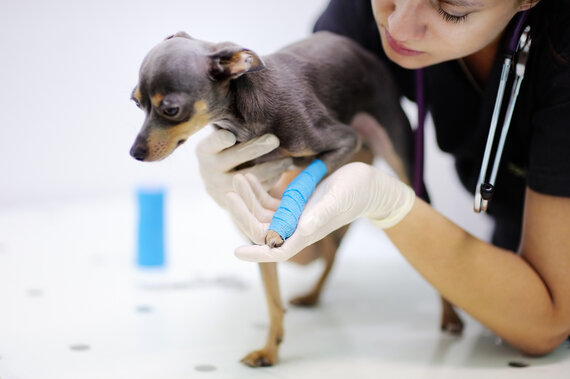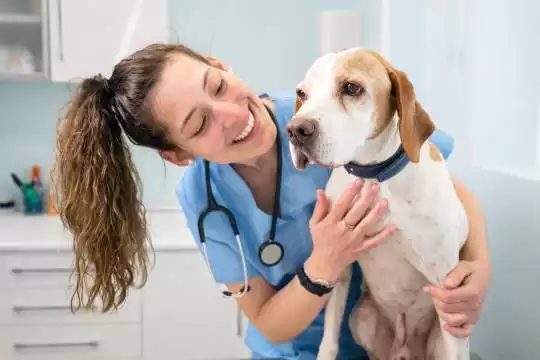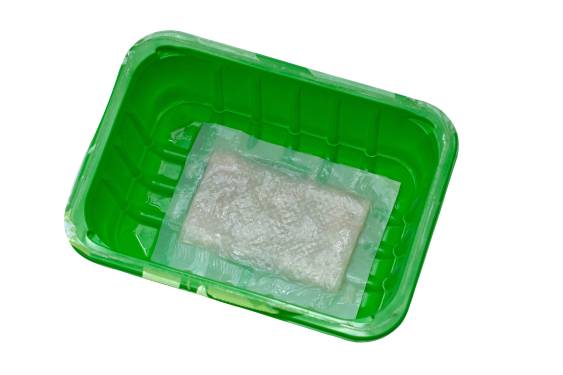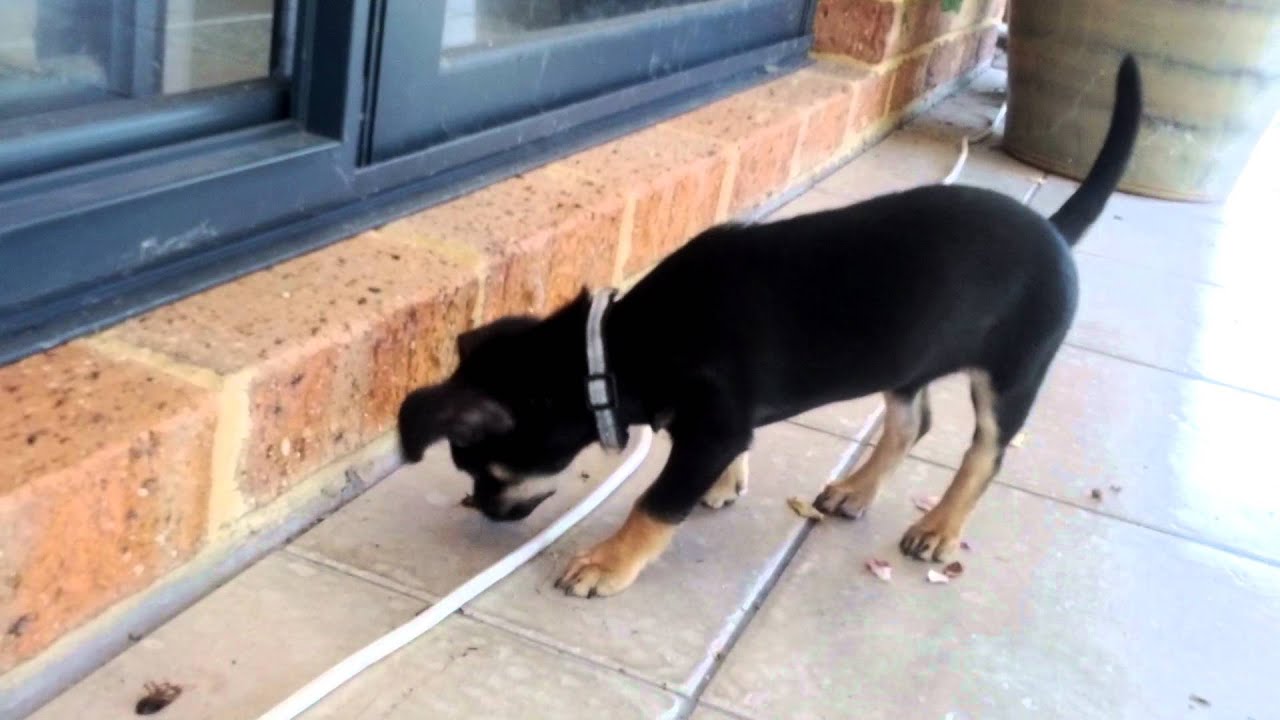Did you know dogs can have sprains, just like us? In fact, it can happen to any of our canine companions, whether they’re young, old, in shape or overweight. Our pups are busy with us all day long, playing, walking, and running. So, it’s no wonder they occasionally suffer from a painful sprain. In this article, we’ll take a look at what a sprain is, the symptoms associated with this injury and how a sprain should be treated. Let’s get started!
Connect with a verified veterinarian in minutes. Licensed vets are available 24/7 to answer your questions. No need to worry about your furry family member.

How Dogs Walk
Have you ever noticed how your fur baby walks? If you pay attention, you’ll see he’s actually walking on his toes! His ankles are further up his leg than ours are and his knees are bent slightly forward.
Walking, running and jumping put a lot of weight and stress on your dog’s muscles and joints. There are times when your fur baby may overdo it when chasing the cat next door, or that squirrel in the backyard. This can lead to sprains and strains of your dog’s front and back legs. Injuries are most commonly seen in a dog’s shoulders, elbows, wrists, toes, ankles, and knees. Strains and sprains are very common injuries in dogs. But what is the difference between a sprain and a strain?
The Difference Between a Sprain and a Strain
A strain affects the muscles or tendons. Tendons connect muscles to the bones. A strain may be caused by overextension of the limbs, and commonly occurs when a dog falls, jumps, or slips.
Sprains, on the other hand, affect the ligaments that connect two bones, which can cause damage to the joints. The most common sites for sprains are a dog’s limbs. A sprain can happen to any dog, for example, if they jump off the couch, step in a hole, etc. A torn cranial cruciate ligament (CCL) is one of the most serious types of sprains. The CCL connects the bones of a dog’s knees. The ligament can tear or rip, which causes severe pain. Any injury could cause a joint’s ligaments to be stretched, ruptured or twisted, which leads to a sprain.
OK—you probably have an idea of what this may feel like for your fur baby, especially if you’ve suffered a sprain at some point. Let’s take a closer look at some of the symptoms of a sprain and compare them to that of a broken leg.

Review symptoms, medications & behavior to keep your pets healthy with a Vet Online in just minutes.
Ask a Vet Live NowIs my Dog’s Leg Broken or Sprained?
It can be difficult to tell if your dog’s leg is sprained or broken, especially if he’s got a hairline fracture. Here are some clues that may help you tell if your fur baby has a broken leg or a sprain:
- Broken bone: your dog probably will not want to put any weight through his leg. If your dog is able to put some weight on the leg, and seems otherwise comfortable you can wait a few hours to see if the injury improves. If not, he needs to see a vet as he could have a fracture or other injury. Another sign of a broken leg is extreme pain, though this can also be caused by a severe sprain. If you can see a broken bone poking through your dog’s skin, this needs immediate veterinary attention. You might notice that your dog’s bones look out of alignment and this is probably due to a broken bone.
- Sprain: your fur baby may put some weight through the leg, or he may not. A severe sprain can cause pain that’s as severe as a broken bone.
The signs and symptoms for a fracture or a sprain are similar. Let’s take a look.
Signs & Symptoms of Sprains in Dogs
If your fur baby suffers a sprain, you may notice one symptom, or he may display several. Symptoms can be anywhere from mild to excruciating, it depends on how bad the damage is. However, if your canine companion is in severe pain, you’ll have no doubt about it. The symptoms of a sprain can mimic other medical conditions such as bone cancer, arthritis, or hairline fractures. So, if you notice your pup having any of the symptoms below, it’s time to call the vet:
- Pain that’s mild to excruciating
- A swelling of the legs, joints, or paws
- Limping or lameness
- Excessive licking of an area (due to the pain)
- Joints that are red/inflamed
- Decrease in physical activity (playing or even normal activities)
- Aggression that is not warranted or expected
- Loss of appetite
- Not putting weight through a leg
- Crying, whimpering, or other abnormal vocalization
Even if your pup isn’t showing signs that he’s in severe pain, if he’s limping at all then there’s a problem.
If your dog’s limp is mild but he’s still limping 24 hours after he got hurt, it’s important to get your fur baby to the vet as soon as possible.
Diagnosis of Sprains in Dogs
The vet will begin by asking questions about when the injury happened and what symptoms your fur baby displayed at the time. They’ll then ask for details on how the injury has developed since that time. For instance, has the pain or swelling become worse? What other symptoms have you noticed? Is your dog’s limp worse than when the injury occurred? All of these questions will help give the vet the information they need to determine a possible cause of the pain. Next, the vet will give your dog a physical exam. They’ll pay special attention to any areas that are painful and will check the range of motion in his joints. After the exam, the vet may also need to x-ray your dog to check for possible fractures, signs of osteoarthritis, or evidence of a soft tissue injury.
In some cases, your vet may also need to perform an arthroscopy. This is a surgical procedure where the vet will make a small incision and insert a small camera (scope). This gives them a clearer image of the sprain or fracture and can help make a definitive diagnosis. It’s also possible the vet could suggest a CT scan or an MRI scan, which will give the vet a more detailed image of any tissue or bone damage. Another diagnostic tool the vet may use is ultrasound which they can use to better visualize soft tissues such as tendons and ligaments. The vet might grade the sprain based on the level of damage. These range from Grade I to Grade III:
- Grade I: only a minor damage to the ligament, where the joint is undamaged. There may be some mild swelling and pain, but your fur baby is most likely able to walk.
- Grade II: a larger portion of the ligament is damaged, and this may be accompanied by severe swelling. Your pup may be able to walk, but he’s probably limping or lame.
- Grade III: this is the most severe grade of sprain. Here, the ligament is completely ruptured. Sometimes there may also be bone damage and your fur baby probably won’t put any weight through his leg.
Treatment
The type of treatment your fur baby will need depends on the grade of the sprain. The recovery time for a dog with a sprained leg will vary, again depending on the grade of his sprain.He may need anti-inflammatory medication, which will help bring the pain and swelling down.
A Grade III sprain where there is a complete rupture of a ligament often requires surgery to correct and repair the damage. This type of injury can have lasting effects on your fur baby. Some dogs fully recover from the injury, while others are left with some loss of the range of motion in their limb. They may also be more prone to the development of arthritis.Your canine companion will need a long recovery period, during which he must not be allowed to be too active.
If he’s too active, he could re-injure the joint, which could cause even more damage. Any sprain can take up to several weeks or sometimes months to heal fully.
Dog Sprained Leg at Home Treatment
Once your fur baby has seen the vet and received the necessary treatment, you’ll be able to care for his sprain at home. Home treatment for a doggie sprain can involve:
- Giving your dog any prescription medication from the vet—this will most likely be an anti-inflammatory medicine for the pain and swelling. Never give your fur baby an anti-inflammatory medication made for humans. It can be toxic, and could even prove fatal.
- Application of cold (ice packs) or heat as directed by the vet.
- Your fur baby will need a lot of rest. It’s important to keep him quiet and don’t allow him to jump and run. For some dogs, it may be necessary to keep them in an enclosed room or even in a
- Follow your veterinarian’s instructions regarding exercising your dog.
- The vet may prescribe physiotherapy for your dog. They might also suggest hydrotherapy which involves the use of a swimming pool or underwater treadmill to reduce the stress on your dog’s joints whilst allowing him to gain strength and stability in his limb.
- Massage of the painful area can also help make your pup feel better. Only do this if you have been instructed to do so by your veterinarian.
- If your fur baby is overweight, the vet may also advise putting your dog on a diet to lose excess weight and reduce the strain on your dog’s joints
The most important thing to remember is that while the injury is healing, your canine companion will need to live a quieter life. Otherwise, he could re-injure the sprained area, which could lead to even more serious damage. It’s very important to follow all the directions and advice from your vet on how to care for your dog once he’s home.
Consider a Crate
It’s not easy to keep your dog quiet when he has a sprain, especially if he’s a young dog with lots of energy! In that case, you may want to consider keeping your fur baby in a crate. This way, he can stay in the crate to rest and come out for his meals and a little exercise.
Another option is to keep your dog in a room in your house. Your fur baby will need his bed and blanket and access to fresh, clean water. When your dog is in a comfortable room (that he really likes), he will fall asleep pretty easily.
Keeping your dog in a crate or room will keep him from moving around as much and help him recover faster.
Use a Recovery Sleeve or E-Collar
Is your dog biting his sprained leg? If so, you may want to consider investing in an e-collar or a recovery sleeve. These medical devices keep your fur baby from reaching his injury and biting, chewing, or clawing.
It’s a good idea to talk with your vet about which is best for your dog—the recovery sleeve or the e-collar.
Put Your Dog on a Diet
If your fur baby’s sprain was due to his weight, you may want to ask the vet about putting your dog on a diet. The goal is to get your fur baby down to a healthy weight (based on his breed and size).
Your vet may also be able to suggest a suitable dog food for your dog’s age, size, health, and activity level.
Dog Leg Pain Home Remedies
Along with hot/cold compresses, there are some other home pain remedies you can give your dog. You could consider giving your pet a dog joint supplement. There are many different kinds available so it is a good idea to talk to your veterinarian about the best one for your dog. Most of them contain ingredients such as glucosamine, which helps to maintain healthy cartilage within the joints, hyaluronic acid which helps to lubricate the joint, and antioxidants such as Vitamins C and E. You can often buy these joint supplements in different strengths. The most basic strength is usually for preventative purposes in healthy dogs but you can often buy higher strength supplements designed for dogs with a previous orthopedic condition or dogs that have arthritis already.
We hope your dog has an easy, comfortable recovery, and hope he’s back to running and having fun again very soon! In the meantime, as he heals, be sure to keep him quiet and comfortable. Follow your vet’s directions and be sure to give your pup some extra love and attention as he recovers.
Connect with a verified veterinarian in minutes. Licensed vets are available 24/7 to answer your questions. No need to worry about your furry family member.

Gemma Cliffin BSC BVSC MRCVS
This article has been reviewed and approved by an independent Veterinarian: Dr Gemma Cliffin MRCVS is an experienced small animal vet who combines her love of writing alongside working in practice. Since her graduation from the University of Liverpool in 2014 she has worked in a wide variety of roles including first opinion practice, as a night vet and as a locum vet. She has also spent time working at a charity clinic in the Cook Islands which was a challenge but also immensely rewarding. She loves all aspects of veterinary work, but she especially enjoys medicine cases and diagnostic imaging. She is passionate about pain-management, particularly in her more senior patients. She currently works in a first opinion small animal practice in North Yorkshire where she deals with both routine and emergency cases.
Review symptoms, medications & behavior to keep your pets healthy with a Vet Online in just minutes.
Ask a Vet Live Now



